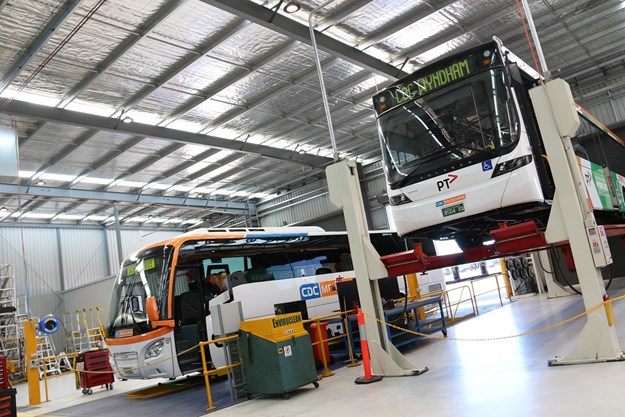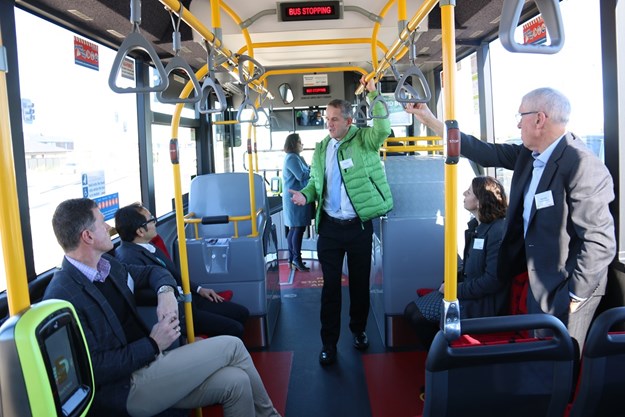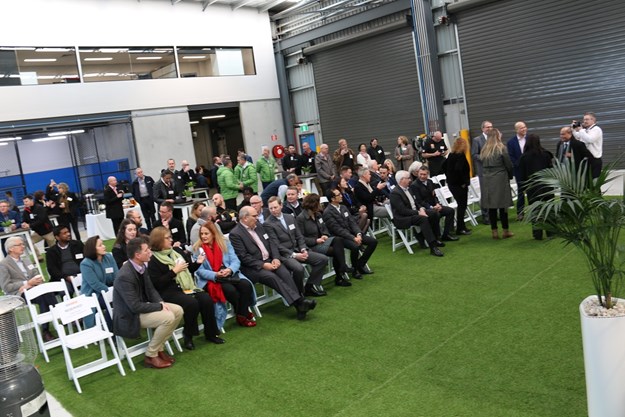ALMOST THREE months after CDC Victoria announced it would be implementing 50 new Volvo-chassis, Volgren-bodied hybrid buses into its fleet, the company held an official function to commemorate the move, recently.
Located at its Wyndham depot in the Western Suburbs of Melbourne, Victoria, the first 30 of the 50 – the single largest order of hybrid buses in Australia to date – were on show in front of industry and political dignitaries, before people were welcomed on board four and taken for a quick spin to experience the new, ‘cleaner and quieter’ technology.
In attendance were guest of honour the Victorian Minister for Public Transport and State member for Williamstown, The Hon. Melissa Horne; local member for Tarneit, Ms Sarah Connolly; and Councillor Walter Villagonzalo from the Wyndham City Council.
With bus operators facing an increasing responsibility to provide clean and sustainable transport solutions, hybrid buses – at least in the shorter term and at least in Australia, given distances to cover and power needed for air-conditioning temperatures to be optimally regulated in our summers – are increasingly being seen as the most logical solution by many industry experts.
Improved public transport that caters for a better environment, driven by cleaner emissions and reduced noise pollution, ultimately leads to improved public health and saves masses of energy, according to Volvo.
CDC Victoria – a subsidiary of ComfortDelGro – is in the first year of its seven-year contract. CEO Nicholas Yap speaking at the launch function, said: “The order of 50 hybrid buses under our Melbourne bus contracts means that roughly 1 in 4 of our metropolitan bus fleet will be a hybrid by mid-2022.”
“Come 2022, the fleet of 50 hybrid buses will service over 90 suburbs across Melbourne.”
THE LINKS
Explaining the common link between the bus entities involved, Yap said: “On 1 November, 1999, our sister company SBS Transit, registered in Singapore the first low-floor Volvo Super Olympian double-decker bus that had a Volgren body.”
“This led to a further order of 50 such buses. Two decades on and we gather here to celebrate the launch of 50 Volvo hybrid buses all with a Volgren body.”
“I believe that aside from a shared vision, the fact that the three parties had a long history of working together helped with the trust that was necessary to deliver this project, Yap stated.
THE BIGGER PICTURE
All 50 new hybrid buses are to be in service on CDC routes in Wyndham, Oakleigh and Sunshine by 2022, CDC Victoria says.
The new Volvo-Volgren-built buses will be progressively rolled out during the next three years.
It’s claimed the buses will reduce fuel consumption and the impact on the environment, while improving passenger experience by delivering a quieter and smoother ride.
The first bus entered service on Route 606 (Elsternwick to Fishermen’s Bend) and 417 (Laverton to Laverton North).
All 50 buses will feature low-floor layouts, Volvo’s Parallel Hybrid driveline and are Euro 6 emission standard – the highest and cleanest level for commercial vehicles worldwide at present, it states.
HOW IT WORKS
Hybrid technology uses the electric battery when idling and travelling under 20km/h. The bus noise is significantly reduced when idling at stops and departing from stops, while trials in Victoria found hybrid buses used 30 per cent less fuel, according to the Victorian State Government.
Thirty hybrid buses will be phased in during the next 12 months; all 50 buses are to be in service on CDC routes in the abovementioned areas by 2022, it confirms.
LESS CO2
According to Volvo at the event, “operating one Volvo hybrid for a year could improve an operator’s carbon dioxide footprint by 27 tonnes.”
“Typically this means 12g less CO2 per passenger mile, and the hybrid also offers a 50 per cent reduction in particulates and NOx.”
Photography: Fabian Cotter + CDC Victoria







.png)
